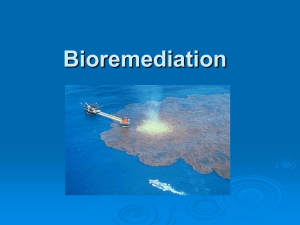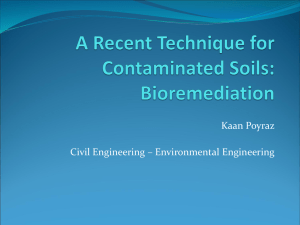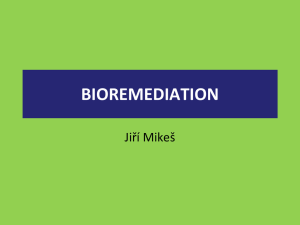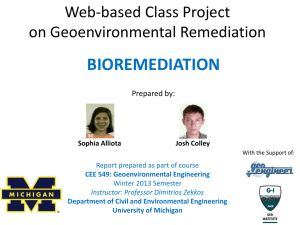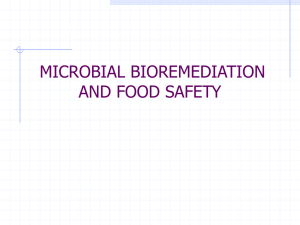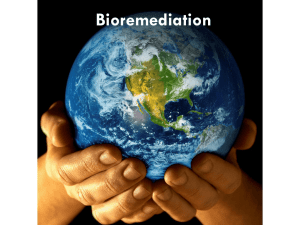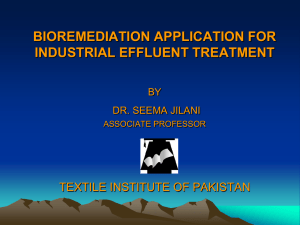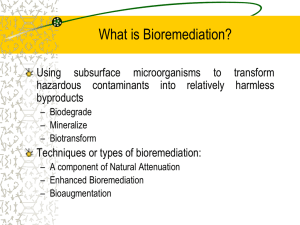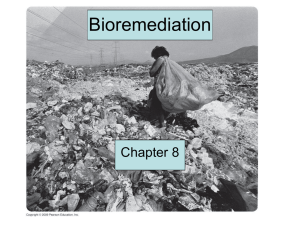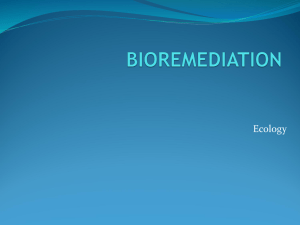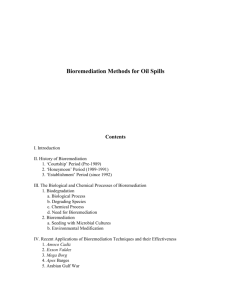Trivol ® Bioremediation - Ameret
advertisement
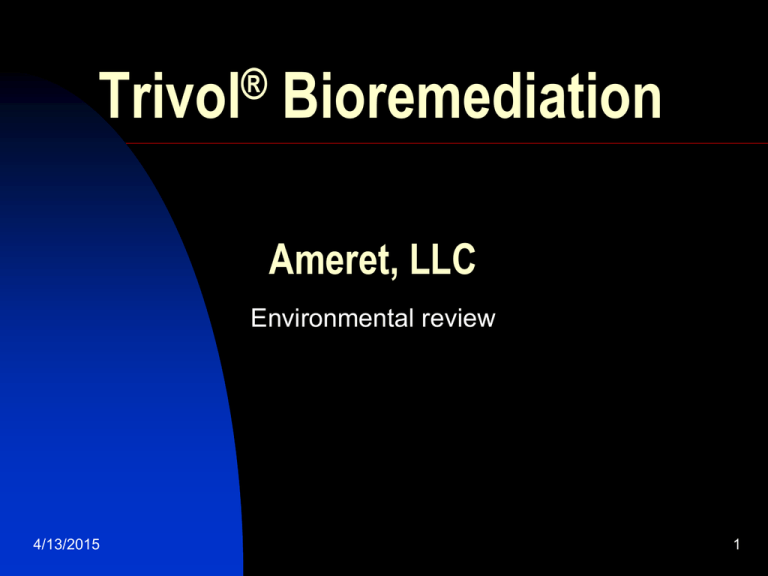
® Trivol Bioremediation Ameret, LLC Environmental review 4/13/2015 1 Introduction Ameret, LLC has been working with the top microbiologists with over two decades of experience to develop a series of bacterial cultures to enhance the biological breakdown process of hydrocarbons for the Oil and Gas Industry Ameret, LLC utilizes a third party fermentation company that specializing in the development and production of microbial products for improved environmental processes. Trivol® Bioremediation technologies differ significantly from competitive products in fermentation, culture type, and product capabilities, they are among the most sought after product for agriculture, water restoration, wastewater and environmental processes. . 4/13/2015 2 Ameret, LLC Latest technologies and equipment Highly scientific personal, all levels Significant production capacity (demand) Ready to ship inventory (in stock supplies) Quality Assurance testing of in coming materials to finished product (quality) Technical support 4/13/2015 3 Trivol® Bioremediation Products www.oilspillremediationproducts.com Culture Isolation, Selection & Enhancement Formulation Development Laboratory and field confirmation of product performance Trivol® Bioremediation products are non-toxic, safe for use around animals, pets, wildlife and humans. Truly the most environmentally friendly products available. 4/13/2015 4 Trivol® Bioremediation Products Completely different technology Different group of microorganisms Different fermentation process Fermentation - Six day multi stage, final five day facultative process Key Factor… The only facultative culture consortium on the market ! 4/13/2015 5 Safety & Performance Toxicity data – clearly your best choice No Toxicity Straight fermentation Enzyme free No chemicals Novel Biological Products Formulations With Unmatched Oxidation Performance Capabilities 4/13/2015 Trivol® HDM (liquid) Trivol® Sludge Away (liquid) 7 Proven Technology for Bioremediation Trivol® Bioremediation technology are two-fold 1) Trivol® HDM - a select consortium of Purple Sulfur microorganisms designed for anaerobic environments, degrades a wide range of compounds, including those that contain hydrocarbons 2) Trivol® Sludge Away – a natural non-chemical humas-based-soilscience-extract designed to speed degradation of dense hydrocarbons and improve ecosystems building value The combination has proven effective in oil and gas bioremediation in aerobic and anaerobic conditions Ameret, LLC offers products and technical support for a wide range of oil and gas spill problems. Trivol® Bioremediation product’s multi stage fermentation , and five day anaerobic process enhances anaerobic functions result in cultures capable of enhancement and controlling gaseous reaction Background - Fermentation in anaerobic environments is an energy-releasing process that takes place in the absence of oxygen, resulting in the breakdown of carbohydrates and complex organic substances into simpler matter. Only certain organisms perform fermentation to obtain energy to carry on these processes. Few to no competitive products obtain energy through fermentation, these products are designed to gain energy through aerobic respiration in the presence of free oxygen. These spore based products are produced in single stage aerobic processes. Trivol® Bioremediation capabilities are derived by type of microorganism carrying on the process, and their development process to achieve necessary anaerobic reactions. Oil pits are strict anaerobic environments where fermentation by microorganisms produce substances called enzymes which speed up chemical reactions to breakdown matter. Trivol® Bioremediation is designed to enhances these functions 4/13/2015 9 ® Trivol Trivol® Bioremediation is designed for Oil and Gas industry and differs from completive formulations. This culture consortium is effective in all ecosystems. The consortium consists of spore and vegetative bacteria. What is the difference? Bioremediation Activity level – spore-forming organisms can choose to ‘shut down’ and go to spore if they do not like their environment; vegetative bacteria cannot go to spore so they must manipulate their environment to meet their needs Functions – vegetative bacteria are much more dynamic in their capabilities over spore-forming organisms Trivol® Bioremediation provides a reduction in any hydrocarbon on land or water and provide related plant benefits by balancing the ecosystems biology. 4/13/2015 10 Addressing Environmental Concerns The environmental effects of oil spills are a concern, particularly with respect to surface water and groundwater quality and to air quality as affected by odors and gaseous emissions from large-scale operations Trivol® Bioremediation addresses most of these issues 4/13/2015 11 Nutrient Retention (Nitrogen) Oil pits and contaminated soil may remove a significant amount of Nitrogen, but Phosphorus and Potassium are not likely to be significantly affected by treatment. Trivol® Bioremediation technology builds biomass that stores nitrogen and significantly reduces the potential 80% loss of nitrogen within ecosystems 4/13/2015 12 Building Soil Biology and Nitrogen Values The key to estimating N availability after application rests on mineralization decay rate expected from the breakdown of organic matter. For crude oil the estimated first-year contribution from organic N can vary from 25 to 50% of the total organic N. This is a function of the breakdown rate of oil in the soil. Trivol® Bioremediation accelerates these reactions, and stores released nutrients in ecosystem 4/13/2015 13 Biological Control of Runoff In many areas there are major concerns associated with managing oil spills related to runoff control Trivol® Bioremediation bio technology controls runoff, reduces water born pathogens, reduces nitrate in water via denitrification, and reduces organic matter in field trenches Trivol® Bioremediation releases nutrient energy contained in hydrocarbons for plant up-take 4/13/2015 14 Microbial Functions Biological enzymatic reactions are involved in the liquefaction, breakdown and stabilization of any hydrocarbon Trivol® Bioremediation technology considers the anaerobic and facultative environmental conditions in ecosystems 4/13/2015 15 Microbial Oil Pit Management To understand bio-augmentation a review of the role of microorganisms and how bacteria function is necessary. Microorganisms are responsible for the enzymatic breakdown, conversion and removal of organic matter from the environment, this biological conversion of oil is all the way to the basic elements of carbon dioxide, water and recycled nutrients (Bio-Mass) Microbes play a key role in breaking down oil and other organic matter in ecosystems BIOLOGICAL TREATMENT , This is a review of microbial enzymatic process and how these select microorganism can enhance the soil or water via improved enzyme processes. 4/13/2015 16 Microbes in Action How Microorganisms Function in field use reducing and converting organic matter to energy for plant up-take 4/13/2015 MICROBIOLOGY and waste management 17 Bio Enzymatic Reactions A biological reduction process to convert matter to energy for pants Extracellular enzyme – are secreted by the cell to breakdown larger materials prior to entering the cell as food Membrane bound enzymes –breakdown dissolved and particulate compounds attached to the cell wall Intracellular enzymes – act on dissolved and compounds that cross the cell membrane Bio surfactants – are also secreted to emulsify compounds such as grease, fats, fatty acids and even petroleum hydrocarbons TIME PROCESS! Understanding Bio-Enzymatic Reactions That Degrade Hydrocarbons Extracellular Enzyme C02 cell bound enzyme H20 Intracellular enzyme 4/13/2015 19 Bio-Enzymatic Reactions A review of how microbial cells grow and divide during organic conversion Oxidation organic matter- CxHyOz – Enzyme -> CO2 + H2O Cell synthesis (growth) CxHyOz + NH3 + P04 + 02 – Enzyme -> Cells + CO2 + H20 Oxidation cell material (cells) + 02 – Enzyme -> CO2 + H20 = NH3 (Weston and Eckenfelder, 1995) 4/13/2015 20 BINARY FUSION - Cell Growth and Division Building Microbial Bio-Mass and Ecosystem Value 4/13/2015 MICROBIOLOGY and waste management 21 Bio-Augmentation Now you know oil pits rely on enzyme reaction and microbiology to keep degrading hydrocarbons. Biological enzyme activity is a key factor in remediation. Trivol® Bioremediation offers significant benefits in hydrocarbon remediation from “top-to-bottom” via consistent enzymatic breakdown of oil. Bio-augmentation with these select cultures significantly improve hydrocarbon remediation. 4/13/2015 22 Growth Curve Building Bio Mass for Improved ecosystem stability and value on application, look at lag to log growth indicating a significant increase in Bio-Mass during oil storage. The declining phase takes place on land application during conversion of matter to plant values 23 Growth Conditions Plus pH – 6 to 8 (7.5 opt) Macro Micronutrients C. N. P = 00 - 5 – 1 Ammonia nitrogen (NH3 (N) -1/mg/r) , Ortho-phosphate (PO4) – 1 mg/r) Temperature (F) 55-110 (opt 70/85) Not important just a review of oxidation reaction on field application of Trivol® Bioremediation products 4/13/2015 24 Soil Webb Crops and Microbe Association Plants produce carbohydrates to generate root microbial contact Soil bound organic matter released by bio enzymatic functions Microbes bind to soil particles and root zones Trivol® Bioremediation technologies build biomass to enhance the ecosystem as well as retain nutrients 4/13/2015 25 Microorganisms are the foundation in the soil web See the first two trophic levels 26 Root systems are the foundation of plants No Treatment vs. Treated Great Root and Shoot Growth Treated 64oz / acre @ planting 4/13/2015 30 Increased yield = 38 to 53 4/13/2015 31 Biological Nutrient Retention 4/13/2015 32 Microorganisms change their polymer production 4/13/2015 34 Create binding detainment films for improved nutrient storage 35 Field Crop Benefits 4/13/2015 Increases soil & plant biology Stimulate root zones and rhizosphere Bind nutrients and hold moisture Controls nutrient run off Fixes Nitrogen from the atmosphere, retains soil values Increase plant health Increase crop yield 36 NITRIFICATION ! Due to a poor understanding of soil biology and plant relationships with these reactions, Nitrification inhibitors have been considered to arrest the rate of mineralization; however, they have not been fully evaluated under field conditions and the results have been variable. Trivol® Bioremediation cultures drive essential nitrification and provide added sources of energy for plants, i.e., ammonia to nitrite- to nitrate with plant utilization of these elements. And don’t forget other biological contributions. 4/13/2015 37 THANK YOU! 4/13/2015 38
